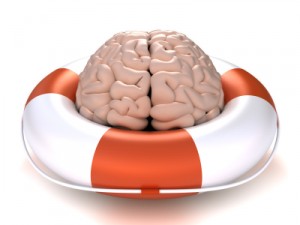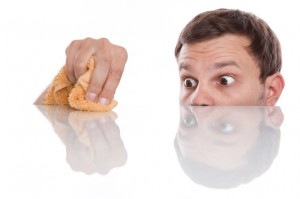Are You The Boss Of You?

I am the master of my fate. Aren’t I?
Like so many teenagers, I once believed that “I am the master of my fate, I am the captain of my soul.” I could take control, think for myself, and guide my own destiny.
It’s a wonderful thought and I really want to believe it’s true. But I keep finding more and more hidden persuaders that manipulate our thinking in unseen ways. In some cases, we manipulate ourselves by mis-framing a situation. In other cases, other people do the work for us.
Consider these situations and ask yourself: Are you the boss of you?
- When you eat potato chips, are you thinking for yourself? Or is some canny food scientist manipulating you by steering you towards your bliss point?
- When you gamble in a casino, are you in control or is the environment influencing you to spend a little more and stay a little longer?
- When you eat chocolate, is it because you love the taste or because the microbes in your gut are controlling your behavior?
- When you play the slot machines, are you deciding how much to spend or is a sophisticated algorithm dispensing just enough winnings to keep you hooked? Are you being addicted in the machine zone?
- When you read social media, do you decide how long to stay on or does a slow, steady drip of dopamine keep you engaged?
- When you don’t eat fish for 20 years, is it because you’re allergic or did you just never think to test your own assumptions? Did you frame yourself?
- When you go rock climbing, is it because you’re an adventurous spirit or because your slow heart beat tilts your life towards cheap thrills (and perhaps a life of crime)?
- When you chat with people in your neighborhood, do they express a wide range of opinions or do they all think more or less like you? When you surf the Internet, do you read only items that you agree with? Will that make you crazy?
- When you vote for a political candidate, is it because you have carefully considered all the issues and chosen the best candidate or because a cynical communications expert has got your goat with attributed belittlement?
- When you vote for stronger anti-crime laws, is it because you think they’ll actually work or are you succumbing to the vividness availability bias? (Vivid images of spectacular crimes are readily available to your memory so you vastly over-estimate their frequency).
- Why are so many restaurants painted red? Why is the woman in the picture (above) wearing a red outfit?
- Is the future ahead of you or behind you? Why did you make that choice?
- When you make a big decision for your company, you never let your biases get in the way, do you? Yet when other people make big decisions, they’re biased most of the time, aren’t they?
- When you choose a mate, are you thinking clearly or is sociobiology influencing your behavior?
- Did you carefully consider and consciously choose those activities that arouse you sexually or was the decision made for you by some combination of hormones, psychology, and genetics?
- Is your primary responsibility as an inhabitant of a given country to be a good citizen or a good consumer?
- When you buy something is it because you need it or because you want it? Perhaps you’re being manipulated by Sigmund Freud’s nephew, Edward Bernays, the founder of public relations. Or perhaps you’ve been brandwashed.
In The Century of the Self, a British video documentary, Adam Curtis argues that we were hopelessly manipulated in the 20th century by slick followers of Freud who invented public relations. Of course, video is our most emotional and least logical medium. So perhaps Curtis is manipulating us to believe that we’ve been manipulated. It’s food for thought.
(The Century of the Self consists of four one-hour documentaries produced for the BBC. You can watch the first one, Happiness Machines, by clicking here).
Turing, Flynn, and Numbskull

I need a life preserver.
In 1950, Alan Turing proposed a test to determine if a computer is artificially intelligent – or at least as intelligent as a human. A judge sits in a room with two computer terminals. One terminal connects to a human; the other connects to a computer. The judge carries on conversations through both terminals. If the judge cannot tell which terminal connects to a human and which to a computer, then the computer has passed the test. It’s intelligent.
There are, of course, two ways that a machine could pass the Turing test. On the one hand, machines might get smarter. On the other hand, people might get dumber. We believe that machines are indeed getting smarter. Apparently, people are getting dumber, too.
But wait, you say — Jim Flynn has documented that people are getting smarter, at least as measured by IQ. Flynn has shown that average IQ scores rose consistently during the 20th century in countries all around the world. On average, the increase was about three points per decade, but it rose as high as 7.7 points per decade in postwar Japan. This trend has become known as the Flynn Effect. (See also here).
Why did we get smarter in the 20th century? Nobody really knows but we assume that it’s a byproduct of better health, nutrition, and education. If so, we should see greater gains among the most disadvantaged people in any given country. And indeed, as New Scientist points out, that seems to be what happened in places like Denmark (which has a very rich trove of IQ tests). IQ scores for disadvantaged people increased consistently while scores for people who already were better off hardly budged at all. The low end was closing the gap with the high end.
At the same time, we were also getting taller. It seems logical to guess that improving health, nutrition, and environment caused us to become both taller and smarter. But average height seems to be leveling off now. Does that mean that average intelligence will do the same?
Actually, intelligence seems to be dropping. In Denmark, average IQ may have dropped 1.5 points since 1998. Other studies have found similar results in places like Australia, Finland, Sweden, and the UK.
Is this cause for worry? Jim Flynn doesn’t think so. He thinks the difference could be due to chance or to small changes in social and economic variables. It may just be an anomaly in the data.
But wait, there’s more to think about:
- Michael Woodley suggests that our average reaction times have dropped since the Victorian era. If true, we’re not as quick on the uptake as we used to be. Reaction time correlates (weakly) with general intelligence so perhaps we’re getting dumber as well as slower. (See also here).
- Richard Lynn and others have argued that smarter people have fewer kids and thus fail to pass along their genetic advantages. Over time, this would result in lower average intelligence in the population.
- Bruce Hood argues, in The Domesticated Brain, that our brains have shrunk by about the size of a tennis ball over the last 20,000 years. We know that the brains of cats and dogs shrank as they were domesticated; perhaps ours did, too.
It’s fair to point out that all of the data sets have some issues. Perhaps Victorian scientists measured reaction times differently than we do. If our brains are smaller than they were 20,000 years ago does that mean we’re dumber or could we be doing more with less? Do smart people really have fewer kids? Is that really what the data show or is it a popular but erroneous meme?
What’s it all mean? Hard to say exactly. I think I’ll go eat some blueberries, oily fish, and broccoli. That should make me smart enough to take the Turing test.
My Microbiome Made Me Do It

Her microbiome made her do it.
My sister craves chocolate. Is it her or her microbiome?
Your microbiome – the 100 trillion microscopic organs living in your body – may weigh up to three pounds (ca. 1,400 grams). In other words, it may be about as big as your brain. It may affect a wide range of diseases including obesity, muscular dystrophy, diabetes, multiple sclerosis, and chocolate abuse
Your microbiome affects disease, but can it affect your behavior? Can it force my sister to eat chocolate? Let’s start with the case of the cat and the mouse.
Toxoplasma gondii is a single-celled parasite that cycles between cat and mice. To complete its life cycle, it needs to pass from cat to mouse and back to a cat again. Toxoplasma lives in the cat’s gut so it’s fairly easy to get from the cat to the mouse – it travels in cat poop.
But how does it get back to the cat? Mice are, of course, deathly afraid of cats and scrupulously avoid them. But not if they’ve been infected with toxoplasma. Then they start wandering around in the open and may even be attracted to the smell of cats. They’re much more likely to be eaten by a cat. Joanne Webster, who studies these things at Imperial College, calls it “fatal feline attraction”.
How does it work? It’s complicated. Somehow the toxoplasma generates dopamine that interferes with the mouse’s brain messaging system. The interference changes the mouse’s behavior.
Remember dopamine? It’s a neurotransmitter that (among many other things) works with the reward system in the brain. Dopamine helps reward us – mice and humans — for good behavior. When we do something well, our systems release dopamine and we feel a sense of pleasure and reward. Problems with the dopamine system can affect a range of behaviors, including ADHD and schizophrenia.
So, is toxoplasma related to schizophrenia? Jaroslav Flegr thinks so. Flegr found that schizophrenics were three to four times more likely to be inflected with toxoplasma than non-schizophrenics. Similarly, E, Fuller Torrey found that women infected with the parasite “were more likely to give birth to schizophrenics to-be.”
Flegr also studied toxoplasma and road accidents. “Both drivers and pedestrians who had been in accidents were almost three times more likely to be infected than comparable individuals who had not been.” They also had poorer reaction times and shorter attention spans. All of this could induce riskier behavior – just like in mice.
What does all this have to do with my sister? Toxoplasma is just one example of the microbes living in the human body. As Carl Zimmer points out, it’s possible that other microbes are influencing our behavior in myriad ways, including food cravings. As Zimmer puts it, “Maybe the microbiome is our puppet master.”
Did you ever wonder why humans are called “social animals”? Perhaps it’s because we can be more successful by collaborating and building societies. Or perhaps it’s because our microbes want to travel from one human to another. It’s much easier on our microbes if we’re clustered together.
And food cravings? Zimmer points out that different microbes like different kinds of food. Perhaps their desires drive our cravings. Zimmer writes that, “Many people crave chocolate fiercely, but it isn’t an essential nutrient. … Perhaps … certain kinds of microbes that thrive on chocolate are coaxing us to feed them.”
If true, does this mean that my sister is not responsible for her chocolate craving? Is she just an innocent bystander, manipulated by her microbial puppet master? It’s an intriguing question that I’ll save for a future article. In the meantime, if you get in trouble with the law, I’d suggest that you say, “My microbiome made me do it.”
(For a related article on zombie spiders, click here).
Effect and Cause

Is it clean yet?
I worry about cause and effect. If you get them backwards, you wind up chasing your tail. While you’re at it, you can create all kinds of havoc.
Take MS (please). We have long thought of multiple sclerosis as an autoimmune disease. The immune system interprets myelin – the fatty sheath around our nerves – as a threat and attacks it. As it eats away the myelin, it also impairs our ability to send signals from our brain to our limbs. The end result is often spasticity or even paralysis.
We don’t know the cause but the effect is clearly the malfunctioning immune system. Or maybe not. Some recent research suggests that a bacterium may be involved. It may be that the immune system is reacting appropriately to an infection. The myelin is simply an innocent bystander, collateral damage in the antibacterial attack.
The bacterium involved is a weird little thing. It’s difficult to spot. But it’s especially difficult to spot if you’re not looking for it. We may have gotten cause and effect reversed and been looking for a cure in all the wrong places. If so, it’s a failure of imagination as much as a failure of research. (Note that the bacterial findings are very preliminary, so let’s continue to keep our imaginations open).
Here’s another example: obsessive compulsive disorder. In a recent article, Claire Gillan argues that we may have gotten cause and effect reversed. She summarizes her thesis in two simple sentences: “Everybody knows that thoughts cause actions which cause habits. What if this is the wrong way round?”
As Gillan notes, we’ve always assumed that OCD behaviors were the effect. It seemed obvious that the cause was irrational thinking and, especially, fear. We’re afraid of germs and, therefore, we wash our hands obsessively. We’re afraid of breaking our mother’s back and, therefore, we avoid cracks in the sidewalk. Sometimes our fears are rooted in reality. At other times, they’re completely delusional. Whether real or delusional, however, we’ve always assumed that our fears caused our behavior, not the other way round.
In her research on OCD behavior, Gillan has made some surprising discoveries. When she induced new habits in volunteers, she found that people with OCD change their beliefs to explain the new habit. In other words, behavior is the cause and belief is the effect.
Traditional therapies for OCD have sought to address the fear. They aimed to change the way people with OCD think. But perhaps traditional therapists need to change their own thinking. Perhaps by changing the behaviors of people with OCD, their thinking would (fairly naturally) change on its own.
This is, of course, quite similar to the idea of confabulation. With confabulation, we make up stories to explain the world around us. It gives us a sense of control. With OCD – if Gillan is right – we make up stories to explain our own behavior. This, too, gives us a sense of control.
Now, if we could just get cause and effect straight, perhaps we really would have some control.
My iPod Is Conscious

Speak, wise one.
Apparently my iPod is a sentient being. It senses its surroundings, understands context, and makes intelligent decisions.
Here’s the latest example. Yesterday, we received this week’s edition of The New Yorker. The cover features a couple kissing on the 59th Street Bridge. This morning, at the gym, my iPod randomly selected (from more than 4,000 choices) the 59th Street Bridge Song, the goopy old standard by Simon & Garfunkel. Even more eerily, the lyrics told me to “Slow down, you’re moving too fast…” which was exactly what I needed to do on the exercise machine I was using.
Clearly, my iPod knew about the magazine (the print edition!) and also knew that I was over-exerting myself. It selected the perfectly appropriate song from thousands of possibilities. Thank you, Steve Jobs.
But wait … really? Clearly the magazine’s cover art primed me to think about the 59th Street Bridge. When I heard the song, I made the connection. That’s the effect of priming. As for the advice on slowing down … well, I wouldn’t have noticed it if I weren’t overdoing it. In other words, I was being primed (or conditioned) in two different ways. I noticed things that I wouldn’t otherwise have noticed. I assumed there was a connection, but it was really just a coincidence.
Coincidences can screw up our thinking in myriad ways. Let’s look at four ways to consider coincidences and causes:
A) It’s a coincidence and we recognize it as such – most people would conclude that my iPod is not conscious … Apple’s not that good. We correctly conclude that it’s not a cause-and-effect situation.
B) It’s a coincidence but we thinks it’s a cause – this is where we can get into big trouble and deep debates. This is a problem in any discipline — like economics, sociology or climate science — where it’s difficult to run experiments. It’s hard to pin down if X causes Y or if Y causes X or … well, maybe it’s just a coincidence. (Maybe it was the rats).
C) It’s a cause and we recognize it as such – we know that certain germs cause certain diseases. So we take appropriate precautions.
D) It’s a cause but we think it’s a coincidence – before the 19th century, we didn’t recognize that germs caused diseases. We thought it was just a coincidence that people died in filthy places.
I suspect that many conspiracy theories stem from Category B. We note a coincidence and assume mistakenly that it’s a cause. The dust bowl in the United States coincided with over farming and also with the rise of communism in Europe. A small but noisy group of people concluded that the dust bowl was not caused by farming techniques and drought but was actually a communist conspiracy.
We can also suffer from Category D problems. I read recently of a man who had a chronic infection in his right ear. Doctors couldn’t figure it out. Finally, the man took some earwax from his left (healthy) ear and stuck it in his right ear. The infection went away. It seemed coincidental that his left ear was healthy while his right ear was not but it actually pointed to a cause. His left ear had healthy bacteria (a healthy microbiome) while his right ear did not. The man suspected that the difference between his left and right ears was not coincidental. He was right and solved a Category D problem.
In a weird way, this all ties back to innovation. If we want to stimulate innovation, we can usefully ask questions like this: “I note that A and B vary coincidentally. Is that really a coincidence or does it point to some deeper cause that we can capitalize on?” While Category B can generate endless debates, Category D could generate novel solutions.
(How do you know if something is true? Click here.)